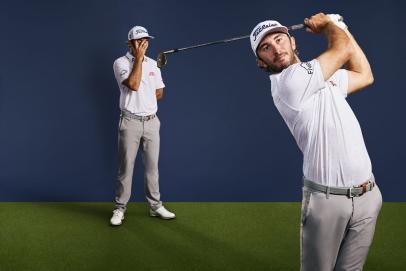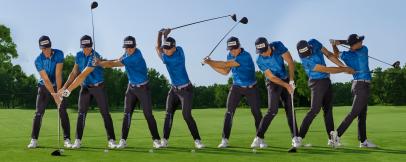tour technique
How to hit all your shots inside 100 yards pin-high

Dom Furore
I grew up playing on a par-3 course at Fargo Country Club in North Dakota. It didn’t take much more than 30 minutes to play its nine holes, and my buddies and I would often get in four loops before the sun set. I miss that course because it was such great practice for my wedges. It’s where I learned how to subtract speed and vary the distance I hit each club and how to control the launch, spin and trajectory of the ball. It’s also where I developed my bread-and-butter, low-cut shot for accuracy.
If there is one place amateurs can pick up strokes, it’s inside 100 yards where the majority of shots take place. Improve your wedge game and you will lower your scores in a hurry. Here are three of my biggest keys to help you do just that. —With Dave Allen
TOM HOGE won his first PGA Tour event, the AT&T Pebble Beach Pro-Am, this season and ranked sixth in strokes gained/ approach the green through May.
1. APPROACH THE BALL FROM THE INSIDE

Since I started working with my swing coach, Scott Hamilton, nearly five years ago, we’ve focused on shallowing my downswing. I used to hang on my lead side too much on the takeaway, which caused the clubhead to get too steep and off line at the top.
Now I set up with my weight evenly distributed between my feet, which helps me rotate into my trail side more easily going back. I also limit the length of my backswing to three-quarters or less for more control. These aren’t power shots, so no need to take it all the way back.
From this abbreviated position, it’s much easier to shallow the club’s path into the ball, which is an essential element to making solid contact. As my arms start down from the top of the backswing, I have this feeling that my pelvis is shifting forward, but my hips haven’t opened fully in relation to my target (above, left). By delaying hip rotation, I can drop the club behind me on a shallower plane, which is what you want with most wedge shots.
As you can see in this photo (above, right), I still have some trail side bend, and my lead shoulder is directly over my hip as the club gets to halfway down. This combination of being shallow with my approach into the ball and feeling on top of it at impact is the perfect recipe to hitting solid wedges. If you come into it too steep or hanging back, you’re either going to skull it or chunk it. I see that a lot from amateur players.
2. HIT IT THROUGH A LOW WINDOW

Dom Furore
Growing up in North Dakota and playing college golf at Texas Christian, I’m used to dealing with a lot of wind. It’s probably why I learned to keep the ball down as much as possible with my wedge shots. But now I do it even when it’s not windy.
As I look at the target, I visualize hitting the ball through a very low window about 10 yards out (above). The lower launch (it’s around 30 degrees) helps compress the ball and creates more spin. If I want to fly it farther, I swing harder. To hit it higher, I might move the ball a little farther forward in my stance, but I don’t change the window substantially. Higher shots tend to run up the face and lose spin, making it harder to predict distance.
Next time you practice, flight all your wedges lower and compare your accuracy to when you try to hit them higher. I bet lower wins.
3. GRIP DOWN AND SHORTEN UP FOR DISTANCE CONTROL

One reason I do so well inside 125 yards is that I keep my technique simple. By doing the same things on the course and in practice, I’ve learned how to subconsciously take speed off a club and hit it shorter if necessary.
I’ve found that the easiest way to do that is by gripping the club farther down the shaft or shortening the length your arms swing back and through—or doing both. For example: I know that if I make my normal backswing with my lob wedge (above, left), the ball will carry 80 yards. I don’t need to grip down. If I want to make it go 70 yards, I’ll grip down two inches on the handle or abbreviate my backswing and follow-through. To hit my lob wedge 50 yards, I’ll shorten my arm swing even more, to about where my arms are parallel to the ground, and grip down some as well (above, right). By establishing benchmarks for each wedge, which you do by calibrating the distance a shot travels to the length of your arm swing and how much you grip down, you can cover a lot of ground and fill a bunch of distance gaps for these shorter approach shots.
You might miss left or right of your target, but if you’re pin-high more often, your scores will come down.


